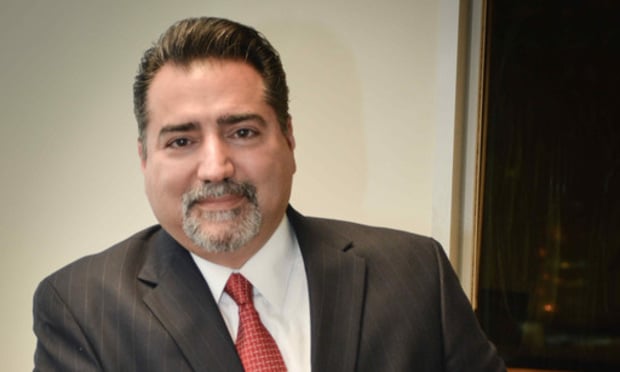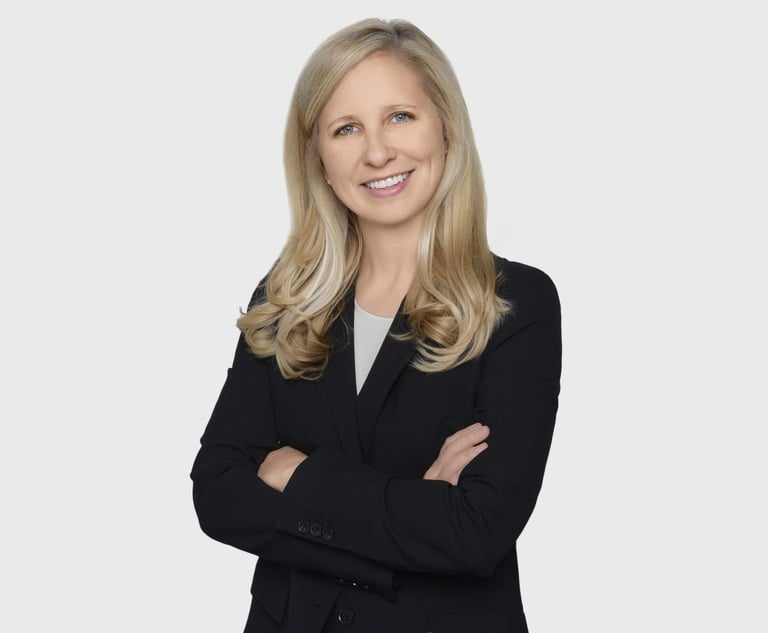Too Drunk to Ride? Ride-Sharing Services May Drop Loyal Clients
With ride-share services appealing increasingly to late-night partygoers, Uber seems to be taking more seriously the risks associated with these passengers—particularly the drunk ones.
August 23, 2018 at 09:52 AM
4 minute read
 Robert F. Lewis, of Lewis Fox law firm
Robert F. Lewis, of Lewis Fox law firm
With ride-share services appealing increasingly to late-night partygoers, Uber seems to be taking more seriously the risks associated with these passengers—particularly the drunk ones. Uber's recent moves, including potentially developing artificial intelligence to identify intoxicated passengers, are creating a new set of questions: Is it too late to remove the ride-sharing safety net, and how will restaurants, bars, and community at large be impacted?
Indeed, ride-sharing services like Uber serve over 75 million active monthly riders and provide a valuable safety resource for their customers and the community. While not all users are drunk, ride-share providers definitely appeal to those who had a few cocktails. These patrons can present a variety of difficulties, including dangerous behaviors that can manifest in their drivers' vehicles.
It is indisputable that the increase in popularity and adoption of ride-sharing services has come with a decrease in reported DUI violations and accidents. This decrease doesn't mean that people are drinking less, but rather that they and the drinking venues they frequent are increasingly relying on ride-share services for safer commutes home. In fact, many bars, restaurants, nightclubs and even movie theaters have incorporated the use and promotion of ride-share services to their patrons as part of their security and responsible alcohol service programs.
In my experience, special alcohol license use approvals these days are often tied to a business' commitment to utilize ride-share services for intoxicated patrons. If these passengers are left without a way to get home, we may revert to the days of high DUI traffic violations and more dangerous driving conditions.
The developing AI, whether used for identifying potentially drunk passengers or not, also potentially poses additional liability risks. As reported, the AI is intended to detect and record how quickly and accurately passengers type information, walking speeds, the angles at which phones are held and of course day, time and location. Even if abnormalities in these areas are detected, the AI is still, at best, merely assuming the people may be intoxicated. As any police officer will likely attest, detecting intoxication requires more analysis, as it is very difficult to confirm intoxication without looking someone in the eye and personally observing behaviors. So, the potential for misclassification of riders seems high, and possibly higher than the risk of leaving intoxicated patrons stranded without ride-sharing options.
Aside from risks associated with the increased potential for DUI, how will this new AI store and use information about those labeled as “too drunk to ride,” and the venues they are leaving? With incidents of major privacy breaches repeatedly making headline news, including recorded evidence that may be incorrect, suggesting intoxication or over-service to patrons could be damaging to the individual or business if leaked. Again, another reason why those with the most need for rides may risk driving themselves home.
Rather than refusing service, ride-share providers and drinking establishments may want to consider a higher level of face-to-face scrutiny and cooperation with law enforcement. Ultimately, better training of drivers and alcohol servers can provide better risk assessment and security than any AI in this area. For example:
- Drivers should keep their doors locked and speak to their potential passengers before allowing them to enter their vehicles;
- Ride-share service providers can develop and create an online course on identification of intoxicated patrons for applicant drivers;
- Every business, whether ride-share providers or drinking establishments, should have internal protocols for handling intoxicated patrons and guidelines for contacting law enforcement before intoxicated patrons are left on the street or refused service; or
- Mandatory in-camera monitoring of ride-share vehicles, such as the type used for law enforcement vehicles, can also serve as a safety feature with some deterrent effect. While this option carries some potential privacy considerations, it is still likely better than abandoning intoxicated patrons and forcing them to find their own way home.
It may be too late to shove the cat back in the bag on ride-sharing services. While AI is in its development phases, ride-share providers and drinking establishments should consider a return to the old-school methods of identifying intoxication and keeping law enforcement within reach and on-notice of these risky passengers before throwing them back onto the streets where they can pose the most dangers to themselves and others.
Robert F. Lewis, a partner with LewisFox, focuses his practice on the laws governing alcohol industry members at all three tiers as well as tobacco and other regulated products. He may be reached at [email protected]
This content has been archived. It is available through our partners, LexisNexis® and Bloomberg Law.
To view this content, please continue to their sites.
Not a Lexis Subscriber?
Subscribe Now
Not a Bloomberg Law Subscriber?
Subscribe Now
NOT FOR REPRINT
© 2025 ALM Global, LLC, All Rights Reserved. Request academic re-use from www.copyright.com. All other uses, submit a request to [email protected]. For more information visit Asset & Logo Licensing.
You Might Like
View All
Don’t Forget the Owner’s Manual: A Guide to Proving Liability Through Manufacturers’ Warnings and Instructions
5 minute read


Leveraging the Power of Local Chambers of Commerce: A Second-Career Lawyer’s Guide to Building a Thriving Practice
5 minute readTrending Stories
Who Got The Work
J. Brugh Lower of Gibbons has entered an appearance for industrial equipment supplier Devco Corporation in a pending trademark infringement lawsuit. The suit, accusing the defendant of selling knock-off Graco products, was filed Dec. 18 in New Jersey District Court by Rivkin Radler on behalf of Graco Inc. and Graco Minnesota. The case, assigned to U.S. District Judge Zahid N. Quraishi, is 3:24-cv-11294, Graco Inc. et al v. Devco Corporation.
Who Got The Work
Rebecca Maller-Stein and Kent A. Yalowitz of Arnold & Porter Kaye Scholer have entered their appearances for Hanaco Venture Capital and its executives, Lior Prosor and David Frankel, in a pending securities lawsuit. The action, filed on Dec. 24 in New York Southern District Court by Zell, Aron & Co. on behalf of Goldeneye Advisors, accuses the defendants of negligently and fraudulently managing the plaintiff's $1 million investment. The case, assigned to U.S. District Judge Vernon S. Broderick, is 1:24-cv-09918, Goldeneye Advisors, LLC v. Hanaco Venture Capital, Ltd. et al.
Who Got The Work
Attorneys from A&O Shearman has stepped in as defense counsel for Toronto-Dominion Bank and other defendants in a pending securities class action. The suit, filed Dec. 11 in New York Southern District Court by Bleichmar Fonti & Auld, accuses the defendants of concealing the bank's 'pervasive' deficiencies in regards to its compliance with the Bank Secrecy Act and the quality of its anti-money laundering controls. The case, assigned to U.S. District Judge Arun Subramanian, is 1:24-cv-09445, Gonzalez v. The Toronto-Dominion Bank et al.
Who Got The Work
Crown Castle International, a Pennsylvania company providing shared communications infrastructure, has turned to Luke D. Wolf of Gordon Rees Scully Mansukhani to fend off a pending breach-of-contract lawsuit. The court action, filed Nov. 25 in Michigan Eastern District Court by Hooper Hathaway PC on behalf of The Town Residences LLC, accuses Crown Castle of failing to transfer approximately $30,000 in utility payments from T-Mobile in breach of a roof-top lease and assignment agreement. The case, assigned to U.S. District Judge Susan K. Declercq, is 2:24-cv-13131, The Town Residences LLC v. T-Mobile US, Inc. et al.
Who Got The Work
Wilfred P. Coronato and Daniel M. Schwartz of McCarter & English have stepped in as defense counsel to Electrolux Home Products Inc. in a pending product liability lawsuit. The court action, filed Nov. 26 in New York Eastern District Court by Poulos Lopiccolo PC and Nagel Rice LLP on behalf of David Stern, alleges that the defendant's refrigerators’ drawers and shelving repeatedly break and fall apart within months after purchase. The case, assigned to U.S. District Judge Joan M. Azrack, is 2:24-cv-08204, Stern v. Electrolux Home Products, Inc.
Featured Firms
Law Offices of Gary Martin Hays & Associates, P.C.
(470) 294-1674
Law Offices of Mark E. Salomone
(857) 444-6468
Smith & Hassler
(713) 739-1250






